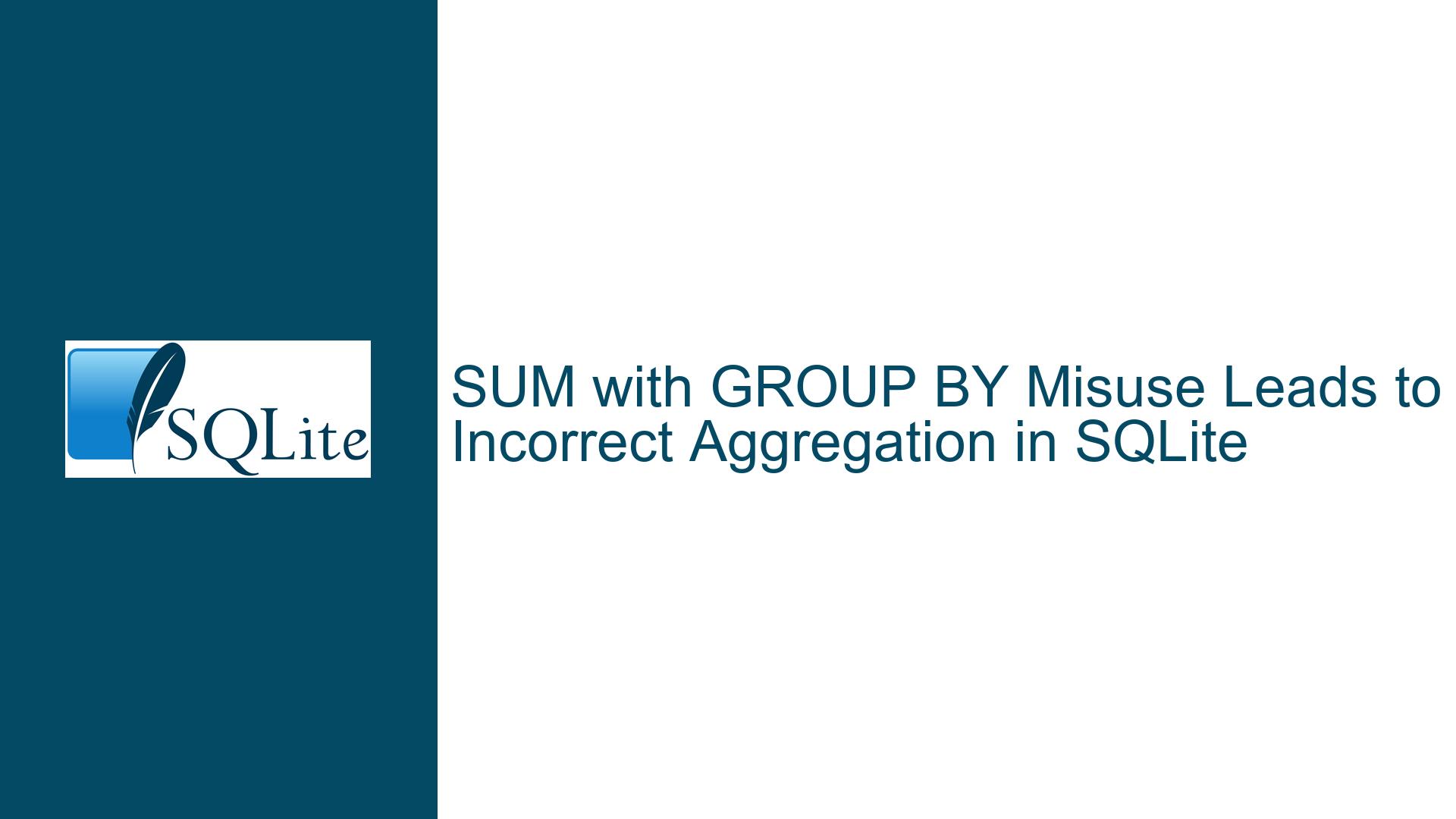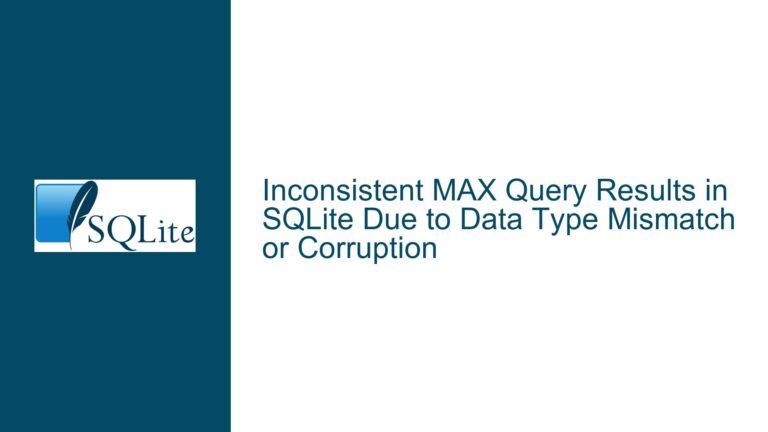SUM with GROUP BY Misuse Leads to Incorrect Aggregation in SQLite
Issue Overview: Incorrect Results When Summing Product Quantities Without Proper Grouping
The core issue revolves around a user attempting to calculate the total quantity for each product in an SQLite database but receiving incomplete results. The initial query structure led to only a single product’s sum being returned instead of the expected multiple grouped results. This problem stems from a misunderstanding of how aggregation functions interact with subqueries and the necessity of explicit grouping in SQL.
The user’s table, myTable, contains product names and quantities with potential duplicates. The goal is to aggregate quantities per product, resulting in a sum for each distinct product. The original query used a subquery to fetch distinct products in the WHERE clause and attempted to sum quantities without a GROUP BY clause. SQLite’s handling of subqueries in scalar contexts and its leniency with "bare columns" in aggregate queries allowed the query to execute without syntax errors but produced logically incorrect results. Specifically, the subquery returned only the first distinct product (e.g., "A"), leading the main query to filter the dataset to that single product before summing. The absence of a GROUP BY clause further compounded the issue by collapsing all remaining rows into a single aggregated result.
Possible Causes: Subquery Scalar Context and Missing GROUP BY Clause
Subquery Returns a Single Value in Scalar Context
In SQLite, when a subquery is used in a scalar context—such as with the = operator in a WHERE clause—it will return only the first row of the result set and discard subsequent rows. This behavior differs from databases like PostgreSQL, which would throw an error for multi-row subqueries in scalar contexts. The original query’s subquery (SELECT DISTINCT(Product) FROM myTable) returns all distinct products (e.g., "A", "B", "C"). However, in the scalar context of WHERE Product = (...), SQLite evaluates the subquery as a single-value expression, effectively reducing it to WHERE Product = 'A'. This unintended filtering restricts the dataset to rows where the product is "A" before aggregation occurs.
Missing GROUP BY Clause for Per-Product Aggregation
Aggregation functions like SUM() require a GROUP BY clause to define the grouping key. Without GROUP BY, the query treats the entire filtered dataset as a single group, producing one aggregated result. In the original query, after filtering to product "A", the SUM(Quantity) correctly calculates 15 (10 + 5), but the absence of GROUP BY Product prevents the query from iterating over all distinct products. The Product column in the SELECT list becomes a "bare column" in an aggregate query, which SQLite resolves by selecting the first value encountered in the group (in this case, "A"). This creates the illusion of correctness for product "A" but omits other products entirely.
SQLite’s Bare Column Quirk in Aggregate Queries
SQLite permits non-aggregated columns in the SELECT list of aggregate queries if they are "bare" (not explicitly mentioned in a GROUP BY clause). This deviates from stricter SQL implementations that require all non-aggregated columns to be part of the grouping key. The original query exploits this quirk by including Product in the SELECT list without a GROUP BY clause. However, the value of Product is undefined in standard SQL terms, as the aggregation collapses multiple rows into one. SQLite resolves this ambiguity by selecting the first value from the underlying data order, which may not align with user expectations.
Troubleshooting Steps, Solutions & Fixes: Correct Aggregation with GROUP BY and Subquery Handling
Step 1: Use GROUP BY to Define Aggregation Groups
The primary fix is to include a GROUP BY clause specifying the column(s) that define the aggregation groups. For per-product sums, group by the Product column:
SELECT Product, SUM(Quantity) AS mySum
FROM myTable
GROUP BY Product;
This query partitions the dataset into groups based on distinct Product values, then applies SUM(Quantity) to each group. The result will include one row per product with the corresponding total quantity.
Step 2: Avoid Scalar Subqueries for Multi-Value Comparisons
If filtering by distinct values from another query is necessary, use IN instead of = to handle multiple results:
SELECT Product, SUM(Quantity) AS mySum
FROM myTable
WHERE Product IN (SELECT DISTINCT Product FROM myTable)
GROUP BY Product;
While redundant in this specific case (since all products are already in myTable), this approach demonstrates proper handling of multi-row subqueries. The IN operator correctly matches against all values returned by the subquery.
Step 3: Validate Subquery Results in Scalar Contexts
To diagnose unintended scalar subquery behavior, test subqueries independently. Execute the subquery:
SELECT DISTINCT Product FROM myTable;
If this returns multiple rows, using it in a scalar context (e.g., WHERE Product = (...)) will truncate the result to the first row. Replace scalar comparisons with set-based operators like IN, EXISTS, or joins when multiple values are expected.
Step 4: Understand SQLite’s Bare Column Handling
When writing aggregate queries, explicitly include all non-aggregated columns in the GROUP BY clause to avoid relying on SQLite’s bare column behavior. For example:
SELECT Product, SUM(Quantity) AS mySum
FROM myTable
GROUP BY Product;
Here, Product is both a grouped column and a non-aggregated column, ensuring deterministic results. If additional non-aggregated columns are needed, expand the GROUP BY list or apply aggregation functions to them.
Step 5: Compare with Strict SQL Mode (Optional)
To emulate stricter SQL behavior and catch potential errors, enable SQLite’s ONLY_FULL_GROUP_BY mode:
PRAGMA temp.options = 'ONLY_FULL_GROUP_BY=1';
Attempting the original query in this mode would trigger an error, highlighting the bare column issue:
Error: ambiguous use of column: myTable.Product
This helps identify queries that rely on SQLite’s quirks rather than standard SQL semantics.
Step 6: Analyze Query Execution Plans
Use EXPLAIN QUERY PLAN to inspect how SQLite processes the query:
EXPLAIN QUERY PLAN
SELECT Product, SUM(Quantity) AS mySum
FROM myTable
WHERE Product = (SELECT DISTINCT Product FROM myTable);
The output will show a SCALAR SUBQUERY step, confirming that the subquery returns a single value. Contrast this with the corrected query’s plan, which includes a GROUP BY step and full table scan for aggregation.
Step 7: Cross-Database Validation (Optional)
Test the query in other databases like PostgreSQL or MySQL to observe different behaviors. For example, PostgreSQL rejects multi-row subqueries in scalar contexts:
-- Fails in PostgreSQL
SELECT Product, SUM(Quantity) AS mySum
FROM myTable
WHERE Product = (SELECT DISTINCT Product FROM myTable);
This returns an error:
ERROR: more than one row returned by a subquery used as an expression
Such comparisons reinforce the importance of understanding database-specific behaviors.
Step 8: Indexing for Performance Optimization
For large tables, add indexes on columns used in GROUP BY or WHERE clauses to speed up aggregation:
CREATE INDEX idx_myTable_product ON myTable(Product);
This allows SQLite to quickly locate rows belonging to each product group, improving the efficiency of both the aggregation and any subqueries.
Step 9: Testing Edge Cases
Validate the solution with edge cases, such as:
- Products with zero quantities (ensure they appear if needed).
- NULL values in the
Productcolumn (GROUP BY treats NULL as a distinct group). - Case sensitivity (SQLite’s default
GROUP BYis case-sensitive).
Adjust the query as needed. For example, to handle case-insensitive grouping:
SELECT LOWER(Product) AS Product, SUM(Quantity) AS mySum
FROM myTable
GROUP BY LOWER(Product);
Step 10: Documenting Query Logic
Annotate the query to clarify its intent for future maintainers:
-- Sum quantities per product, grouped case-sensitively
SELECT
Product, -- Grouping key
SUM(Quantity) AS mySum -- Aggregated quantity per group
FROM myTable
GROUP BY Product; -- Explicit grouping by product
This reduces the risk of misinterpretation and unintended modifications.






